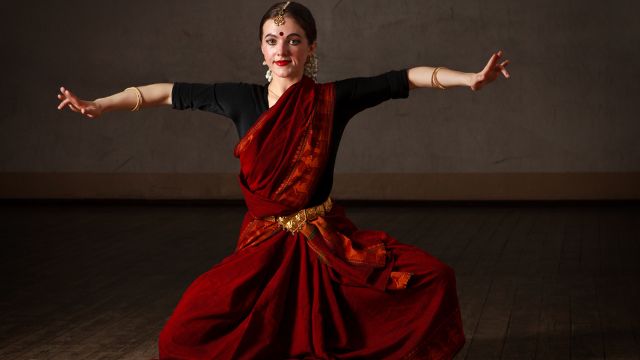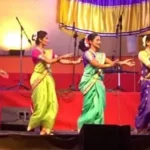Puducherry has become a very important center of art and spirituality. The culture that prevails in this land is not same as anywhere else. Tranquility and purity, these are the two important factors that reign in their artistic creations. The dance forms that are prevalent in Purducherry are exquisite and unique. They show the pure creativity of the human movement, offering a serene expression of the finer senses. Puducherry’s art glows with these artistic expressions.
Bharatanatyam:

The South Indian traditional dance technique Bharatanatyam dominates Puducherry’s expressive arts. Puducherry locals appreciate this Tamil Nadu temple-inspired dance. Traditional dancers with ornate jewelry perform this skill with elegant and precise motions. Every Bharatanatyam gesture tells mythical and spiritual stories. Bharata Natyam was a sacred offering from Tamil Nadu temples. This wonderful dance form used mythology, storytelling, and spirituality throughout history. Visitors are still captivated by its inventive authenticity and emotive plot. Bharatanatyam shines in Aurobindo Ashram in Puducherry. Spiritual giants like Sri Aurobindo and the Mother, whose visionary arts contributions are revered, fostered Bharatanatyam. This dancing form has spirituality and dedication since disciples and pupils have spent their lifetimes learning and mastering it. Bharatanatyam’s beauty and grace are shown at the Aurobindo Ashram. Dancers may improve and discuss Indian mythology and spirituality here. Performances enhance Puducherry’s culture and creativity.
Karakattam:
Puducherry’s cultural events include joyful Tamil Nadu dance Karakattam. This joyous dance genre headlines festivals and other gatherings. Karakattam is a captivating rural dance where dancers balance pots of water on their heads and execute precise footwork and rhythmic maneuvers that mirror life’s cycles. Karakattam’s appeal is dancers skillfully carrying water pots. These magnificent pots represent Puducherry’s riches and prosperity. Dancers’ perfect balance throughout complex footwork reveals their skill and dedication. The performers’ bright clothes and jewelry enhance Karakattam. A dancer’s bright outfit shows rural life’s rich tapestry and cultural diversity. Jewelry shimmers, making Karakattam a visual feast of Puducherry’s celebration. Life is celebrated in Karakattam, not only dance. In rural Puducherry, agriculture and environment coexist. The dance represents the land’s wealth and the people’s thankfulness for life. Karakattam unifies communities during celebrations. A happy dance draws participants and observers, building harmony. Karakattam celebrates Puducherry’s culture and tenacity.
Kolattam:
Puducherry values kolattam, a vibrant communal dance form, particularly during Navaratri and other happy occasions. While dancing to traditional music, dancers build complex patterns using colorful sticks. Kolattam is more than a dance, it’s a vibrant display of unity and pleasure that epitomizes Puducherry’s festivities. Kolattam unites people in delight. Groups of dancers construct a stunning and dynamic tapestry using rainbow sticks. Festivals build community and entertain with step coordination and rhythm. Kolattam’s worth goes beyond fun. Celebrating cultural beliefs and rituals brings people closer. This dance honors Puducherry’s distinct past, making performers and viewers proud. Rhythmic motions and traditional music make the dance visually and aurally appealing. Celebration-themed music boosts spirits. Kolattam is pleasurable when sticks struck in accordance with the music. In Puducherry, Kolattam represents culture. Its vibrant creativity protects the region’s rich cultural past for future generations. This dance teaches and entertains, encouraging people to appreciate their history and values.
Thappattam:
Puducherry’s Thappattam dance revolves about Dalits. This wonderful dancing form shows minority survival and culture. Thappattam, rhythmic handclapping to traditional drums, is more than entertainment. It chronicles the region’s disadvantaged’s struggles, accomplishments, and resilience. The major lure of Thappattam is its rhythmic handclaps. Harmonized clapping by group dancers is engaging and emotional. Thappattam’s story is held together by rhythm. Dalits express their goals, ambitions, and difficulties in thappattam. Every hand motion and loud clap communicates a narrative. Thappattam lets Puducherry’s disadvantaged express their identities, struggles, and determination.
Oyilattam:
Tamil Oyilattam dance has enriched Puducherry’s culture. This enchanting dance goes circularly and sways to folklore and mythology music. Bright peacock feathers and small drums help dancers produce a stunning spectacle that satisfies the eyes and soul. Oyilattam’s circular movements are graceful. Dancers move rhythmically. Tamil mythology is depicted by these swirling motions. The dancers perform to old-time music. These songs link the past and present with timeless themes of heroism, love, and mysticism. Lyrical storytelling gives Oyilattam emotional depth and lets listeners experience Tamil culture’s rich narratives. Dancing with bright items enhances Oyilattam’s visual and auditory appeal. Peacock feathers express dancers’ feelings with their brilliant hues. Performers and audiences are moved by “urumi melam,” little drums that enhance the auditory experience. More than a dance, Oyilattam celebrates tradition and narrative. Transmission of information and tales spans generations. Tamil mythology and tradition are celebrated in this Puducherry dance. Oyilattam enriches Puducherry’s identity. This sign of continuity preserves Tamil tales and rituals. Oyilattam’s circular and swinging motions, captivating songs, and colorful props represent Puducherry’s cultural energy and timelessness.
Conclusion
As more and more people are visiting Puducherry each year, the art forms of the place are growing more popular. Dance is, obviously one of them. As this city has the spirit of community bonding, the dance forms show that kind of unity in their expressions. This is what makes the dance forms of Puducherry quite special in the eyes of the beholders.
Santosh Kumar, the author behind IndiasStuffs.com, is passionate about sharing valuable insights on a variety of topics, including lifestyle, technology, and Indian culture.
Page Contents

